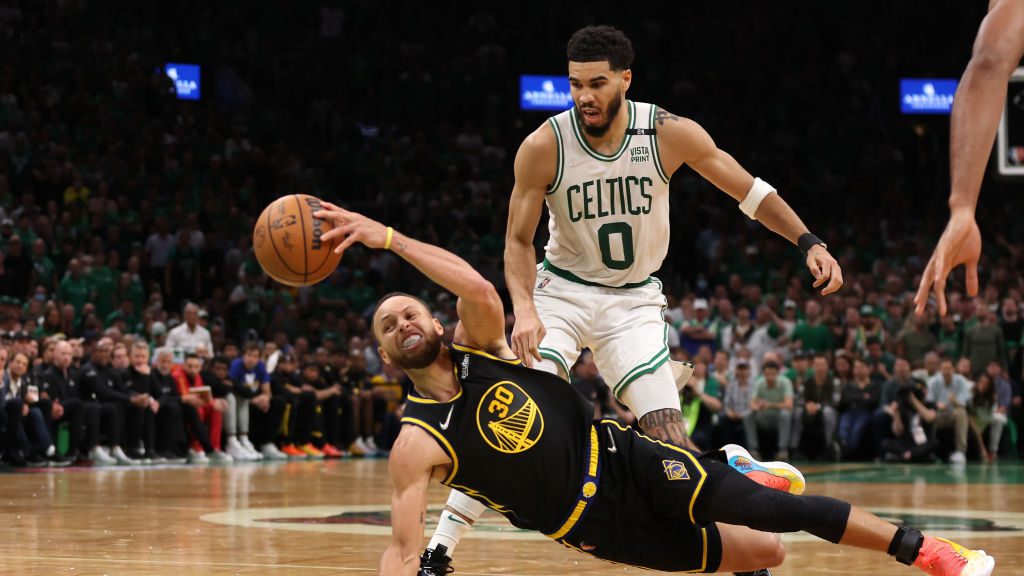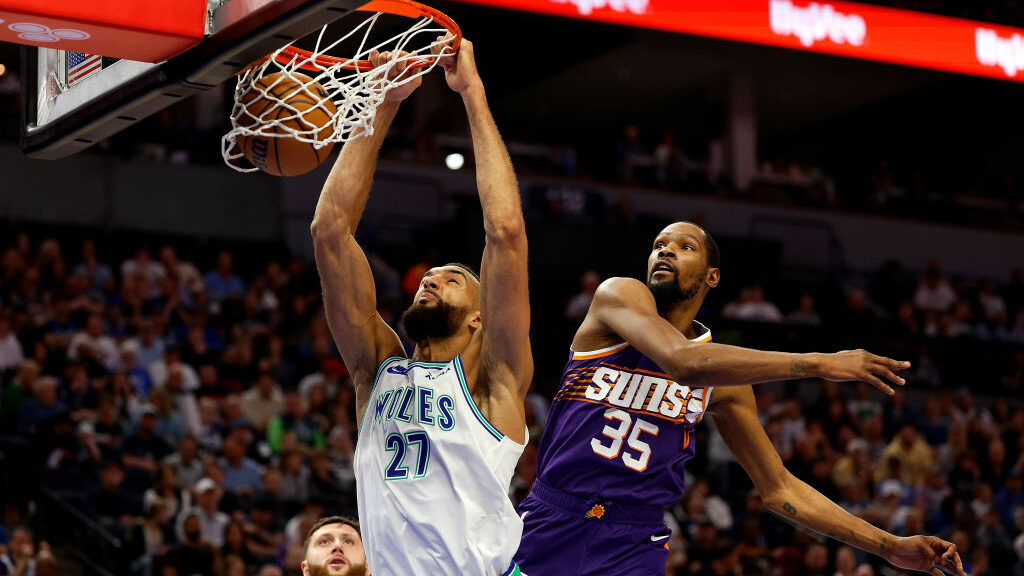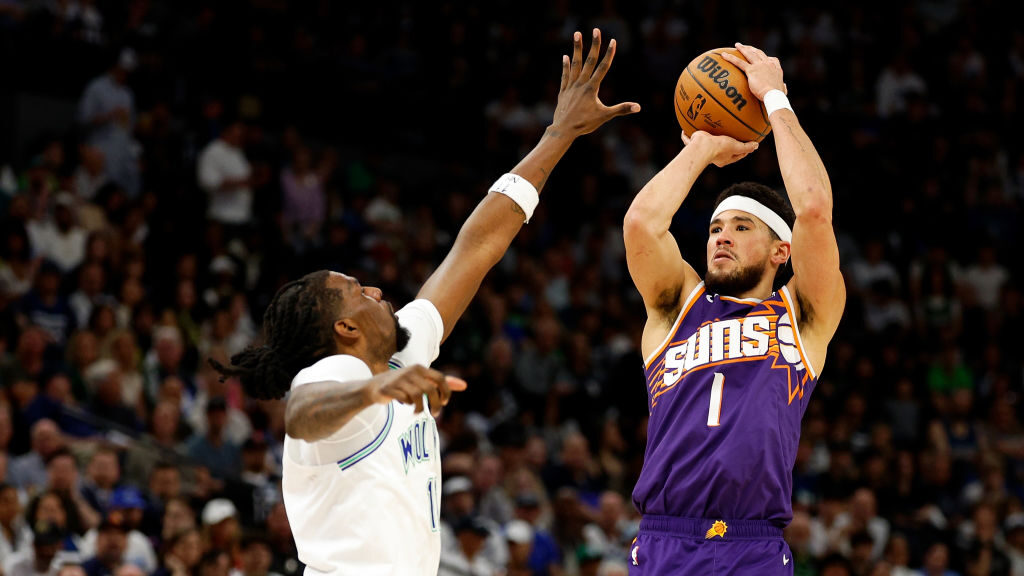What Phoenix Suns can learn from Celtics, Warriors in NBA Finals
Jun 9, 2022, 2:36 PM | Updated: Jun 10, 2022, 12:53 pm

Stephen Curry #30 of the Golden State Warriors loses control of the ball against Jayson Tatum #0 of the Boston Celtics in the fourth quarter during Game Three of the 2022 NBA Finals at TD Garden on June 08, 2022 in Boston, Massachusetts. (Photo by Maddie Meyer/Getty Images)
(Photo by Maddie Meyer/Getty Images)
The Phoenix Suns’ last two seasons include an NBA Finals appearance and a franchise-record 64 wins.
While taking in the obvious, that this year ended in an ugly way, it has been quite the successful two years for the franchise.
With that in mind, you can never stop learning, and what the Boston Celtics and Golden State Warriors have done in reaching the Finals this year showed three areas where Phoenix can improve next season.
Dribble guys
Ever since the 2018-19 season when the Suns went an entire season without a point guard (remember that?!), my podcast co-host Kevin Zimmerman and I have been preaching the importance of having as many threats off the dribble as possible.
Perimeter players, at the very least, need to be able to attack the basket and make the right play when the opportunity presents itself. But when a team has multiple players in the game that can initiate offense or run secondary sets, that’s when modern offenses truly become dynamic.
The Celtics through three games in the Finals have three players averaging double-digit drives per game: Jayson Tatum (14.3), Jaylen Brown (12.0) and Marcus Smart (10.7). Derrick White is close behind at 8.7 a night.
Golden State, meanwhile, has Stephen Curry checking in at 13.0, the lacking-in-burst Klay Thompson with 8.7 and then no one else in the series clocks in at six or more.
For reference, the Suns’ third-leading player in drives per game in the postseason was Mikal Bridges at 4.5.
The Warriors’ main creator behind Curry has been Jordan Poole, who was at 10.3 drives per contest in the first three rounds of the playoffs, but that number has nearly cut in half through three games, down to 5.7. He has had a brutal series, and when both he and Draymond Green aren’t good playmakers, the Warriors cannot win.
One of the best things about playoff basketball is that the longer into the tournament great teams go, the harder it becomes to hide its limitations on either end. That’s what playoff-level offenses and defenses do.
Through most of the series, Curry has had to carry the Warriors’ offense, even though we know that Golden State offense has been superb with balance all year.
Now, players like Smart and White are not especially game-changing offensive talents, but those two plus Boston’s special sauce of two primary initiators with size have allowed the Celtics’ offense to keep the gears spinning outside of a funky Game 2.
Phoenix’s need for more help on the ball to support Chris Paul and Devin Booker was evident already once it was clear that Cam Payne and Landry Shamet were not going to be consistent. Beyond that, players like Bridges and Cam Johnson will need to do more off the bounce to present more challenges as Boston has in this series.
We already saw this in last year’s NBA Finals for the Suns and the offseason will have to address this.
Modern centers
Before we get to the pleasure of watching Boston’s Al Horford and Golden State’s Kevon Looney, let’s go back to the previous Finals again to bring up Milwaukee Bucks center Brook Lopez.
The 34-year-old has a case as the best offensive center of last decade, ranking second in total points over that stretch in the 2010s behind DeMarcus Cousins, per Basketball-Reference. Lopez was a consistent matchup problem in the post and had a deep bag to turn to in those spots.
His breed of player, however, was dying. And Lopez knew that. So, he adapted.
Lopez went from taking 31 total 3-pointers in his first eight seasons to 387 the following year. While his mobility on the perimeter as a defender isn’t sensational, Lopez has squeezed every ounce out of what’s possible for him physically on that end to survive five-out type of play. He became a great rim protector and an extremely aware defender in other areas of the floor that plays his tail off, to the point of making Second Team All-Defense in 2020.
And that’s where we loop back around to Horford and Looney.
Horford is 36 years old and Looney moves like he’s 46 years old. Both are undersized for the 5. And yet, they are very smart defensive players whose motors never stop and provide enough offensive value to hang on the court for big stretches of Finals basketball.
The defense speaks for itself when you watch those two. The offense is where the beauty is all in the details.
Horford’s 3-point shooting, at a bonkers 46.2% this postseason, is good enough already but the playmaking he has been doing has taken his play to another tier. He adjusted to his own Game 2 struggles and Golden State’s gameplan by not only scoring aggressively in the post through mismatches but also going off the dribble.
Looney’s a great passer and screener who has perfected his catch-and-pitch handoffs with the likes of Curry, Thompson and Poole to create decent looks for them out of nothing.
There is immense value in all of the little bits centers like Horford, Looney and Deandre Ayton last postseason do as a whole.
Yes, feed me the rock on the block and watch me work for seven seconds centers are just about extinct. That doesn’t mean centers making $27 million like Horford or Ayton’s upcoming contract aren’t worth that money because of a smaller offensive role.
With the way modern centers are utilized as defensive anchors, switchable defenders, screeners, divers, floor spacers and playmakers in the center of the floor, they arguably have more value now than they did when dream shakes and sky hooks were all the craze. I’d go a step further and even say it’s the most valuable position in the league right now, because finding a center who is at least decent at all of those things is rare.
Boston has one right now that is swinging the biggest series of the year. There are many reasons why Phoenix was eliminated by Dallas but Ayton not giving them what he did against New Orleans or last postseason is in the discussion for what should top the list.
Phoenix has to ask itself if ditching that level of contribution, albeit an inconsistent one, is worth it for the pros of potentially moving on from Ayton.
Beyond that, the Suns need the variety Frank Kaminsky and Dario Saric brought to the position last season. JaVale McGee and Bismack Biyombo were great all year but both provided little to none against Dallas. The Suns need to find that ying to the yang again, whether it’s through Kaminsky, Saric, another player or a suitable small-ball 5.
Nailing the margins
The Celtics have Brown, Smart and Tatum. The Warriors have Curry, Green and Thompson. The Suns have Ayton, Booker and Bridges.
Getting the cream of the crop in your roster from the NBA Draft is something all three of these teams have achieved but the two still playing have been better about filling in the margins.
Boston’s great three-year run in the draft of Robert Williams III (27th, 2018), Grant Williams (22nd, 2019) and Payton Pritchard (29th, 2020) produced three key rotation players. Golden State didn’t do too shabby with Looney (30th, 2016) and Poole (28th, 2019), either.
While we should mention the Suns’ current front office is only three years into this, the hit on Cam Johnson in 2019 is the only similar type of capitalization on value we’ve seen. The misses on Ty Jerome (four picks before Poole), Jalen Smith (10th, 2020) and trading their 2021 first-rounder for Shamet sting when looking at the lack of depth this postseason and in the future.
And to that point on Shamet, the Celtics’ midseason acquisition of White has had the type of impact we expected from Shamet. And that was for White’s cap number off a four-year $70 million deal, the type of contract the Suns could look to acquire this offseason.
But to give Phoenix credit, the trade for Paul is what both of these Finals teams did to a lesser degree as well. Horford and Andrew Wiggins were two huge contracts almost no one wanted that each organization got in their system and turned into the best versions of themselves.
Both of these things can be true: James Jones has done a remarkable job and the Suns could also be better in that last 10-15% of roster building to really round things out in the way both Boston and Golden State have.











Comments